If you’d told me, even just a handful of years ago, that I would be living on Martha’s Vineyard, wait — no — Chappaquiddick Island full time, year-round, maybe even forever — I would’ve said you were mistaken. It’s not that I haven’t had a lifelong love affair with the Island, the bigger one, that is. After traveling for two days in the back of a station wagon with my older siblings, from the time I was two weeks old, we’d arrive on the Island and spend the month every August. Mine was a summer romance — abandoned at the end of the season and more or less forgotten as soon as September came around and I was back in my “real” life.
There were the early golden years: gracious family houses dotted throughout picturesque Edgartown, generations of near and distant relatives just around the corner. It was an idyllic time of family picnics at South Beach, nighttime skinny dips at Bend-in-the-Road, blackberry picking, and crabbing in our rowboat on Eel Pond.
But Augusts came and went, older siblings went off to college and beyond, moving to jobs and lives in NYC, San Francisco, and Martha’s Vineyard(!). With a farm to tend in Illinois, my mother and stepfather spent less time on the Island during the busy high season. The family houses were rented and if I was able to come on my own during high school and college summers, I would stay with my grandfather and make money cleaning houses and waitressing at the Harbor View, hitchhiking to the beach on my days off and sneaking out to smoke and drink with my friends at night.
Visits to the Island became more fleeting when I, too, moved to NYC after college for work, escaping the city for the occasional weekend to stay with my sister and her swordfisherman boyfriend in Vineyard Haven. It wouldn’t be until a decade later when I’d be able to return with children of my own to the golden Augusts of my earliest memories. We’d stay in my grandparents’ house in Edgartown, and though they were gone, everything was just the way it had been — the medallion wallpaper, the scent of cloves in the old wooden bureau drawers.


As an adult, every August I shopped at the Island farmstands, marveling at the varieties of vegetables. When my children were small, an August highlight was the Agricultural Fair — we were always mesmerized by the sumptuous array of produce displayed on paper plates in the exhibit hall. When my oldest was 10, and for the next 10 years, we volunteered together to assist the judges in the vegetable and fruit category, me keeping track of all the winners in an official ledger, while my daughter wrote their names on the back of the ribbons, attaching them to the appropriate display — our behind-the-scenes perspective giving us an insider’s view of the Island’s agricultural community.
Having grown up in a family of enthusiastic eaters with a generous and gifted cook for a mom, cooking came naturally to me. It turned out that I derived real satisfaction from feeding people; food was a language I could understand. From the age of 11, I cooked with my best friend after school, following fancy recipes from our mothers’ housekeeping magazines. At boarding school, I made vegetarian dinners for groups of students at our teacher’s on-campus house. During one of my teenage Vineyard summers, my best friend came to stay and we cooked dinner for my grandfather every single night, keeping track of our culinary efforts with elaborate handwritten menus. During college in Ann Arbor, I got my first cooking job at a macrobiotic restaurant, learning the ropes in a transformative kitchen environment where each worker was trained to perform every task from dishwashing to line cooking. Living and working in NYC after college, I went from cooking tiny elegant dinners for two or three in my Sullivan Street studio to big spreads for raucous crowds, cooked on a hot plate in the loft I shared with friends on lower Broadway. Then onward and uptown to the East Side with a husband and babies, a proper kitchen, a proper dining room, many meals, many dinner parties.
At this point, even though we happily lived in a brownstone in Manhattan, the country life had become increasingly compelling to me. Having moved as a teenager to a newly purchased 150-acre farm in rural Illinois with my mother, stepfather, and baby sister following my childhood in the northern suburbs, I became captivated with farm life — mowing fields and moving the hay bales with the tractor, feeding the heifers and their calves, helping to plant the kitchen garden, collecting the eggs from our chickens. I then attended the Putney School in Vermont — a working farm and secondary school where farming was as much a part of the curriculum as history.
So when my husband and I decided to leave the city for Connecticut in search of a yard and public schools, we eventually found an 1830s farmhouse and barn with three acres that felt decidedly more country than suburban. At home with young kids, some land, and a husband who traveled a lot, I got more involved with gardening, learning about beneficial insects, soil health, and composting.

Later, newly single and my babies now in high school, I was ready to figure out my own next steps. A friend who was a working chef had gone to the French Culinary Institute in NYC and recommended I check it out. I enrolled in FCI’s nine-month culinary program. Leaving home every morning at 6:30 am to be in my chef’s whites at my station, then back to Connecticut by 5 pm to be a mom proved a grueling yet exhilarating endeavor. I loved the formality, the memorizing of terms and techniques, the time away from my daily life back in the city. But best of all, when it came time to seek out a restaurant internship as part of my FCI requirement, I learned that Dan Barber, chef of the just-opened restaurant Blue Hill at Stone Barns, the pinnacle of farm-to-table dining, was an FCI alumnus. I’ll never forget the jolt I felt every time I drove onto that spectacular property with its striped plots of produce, burgeoning orchards, roaming pigs, actual stone barns, and the bustling impeccable kitchen that created remarkable food from ingredients grown and raised just beyond the door.
With a grande diplome under my belt (apron ;-), and my dream of opening my own little farm-to-table place in Westport upended by a fragile economy, I found work catering and as a private chef in Connecticut, New York, and the Vineyard, always sourcing as many of my ingredients as possible from local farms.
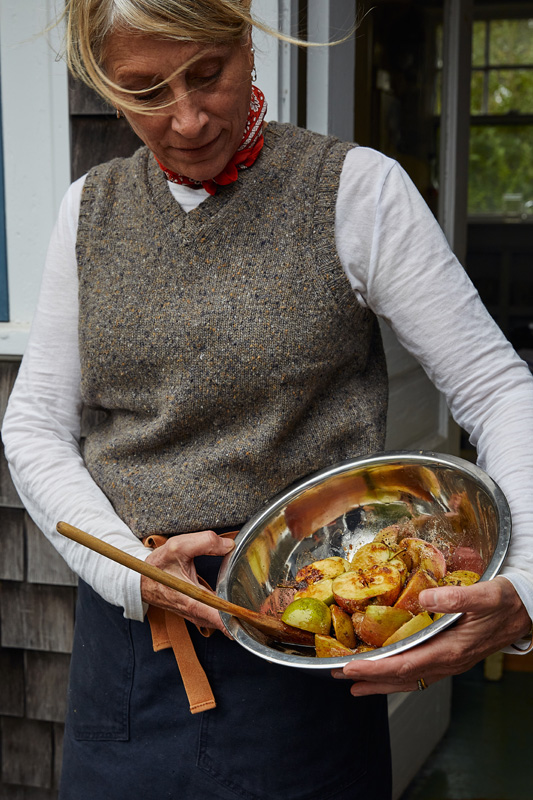
In 2014, after much deliberation, my (second) husband and I bought a little compound of seasonal cottages on Chappaquiddick with proceeds from the West Tisbury house he’d lived in with his late wife and my grandparents’ Edgartown house that I’d inherited, intentionally creating our own version of a life together on the Vineyard, where we’d met.
Meanwhile, the gardens at home in Connecticut were expanding. We planted an orchard, a berry patch, cutting and herb gardens, we started raising laying hens and keeping bees. When we began to produce maple syrup on a substantial scale (even buying the lot next to us with a large stand of sugar maples) we officially became Dirt Road Farm. We rebuilt the old fallen barn on our property and I embarked on the first of our Barn Suppers.
Somehow, it felt like everything that had happened before had led me to these convivial gatherings of friends and strangers around an enormous wooden table in our rustic chic barn, savoring the seasons with menus that celebrated our farm and the farmers and makers in our midst. Seats at the table were filled again and again as we added more dates and even another table to nourish our expanding community. We conducted farm-to-table culinary workshops, hosted educational maple syrup and beekeeping events, and created an annual holiday pop-up farmstand with local farmers and makers selling their wares alongside our DRF goods.
To me, it was unimaginable that I would ever live anywhere else, that I wouldn’t grow old right where I had set my strongest roots. We were strong and resilient, we had worked so hard to get to this place. Yet after 10 years of burgeoning Barn Suppers, a flourishing 425-tap maple syrup operation, and reaping all the bounty we had sown, the pandemic happened, bringing everything we were doing to a halt. The pause allowed us a reckoning, though, the realization that while we were certainly capable and committed to continue as we’d been going, we hadn’t directly considered the scenario that could unfold in, say, 10 years — when it would inevitably become harder to keep up with everything and cost us more to do so.
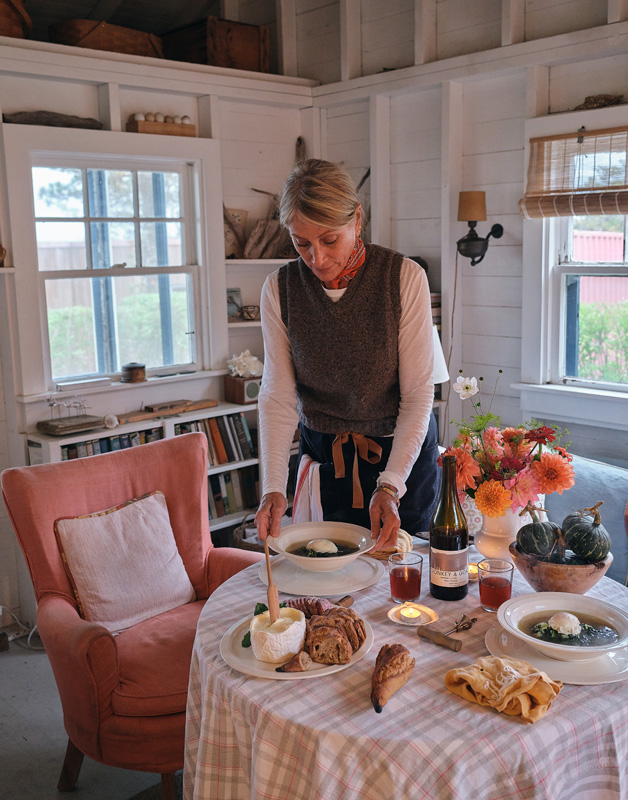
Of course we could’ve one day shut down the maple syrup operation, stopped creating the Barn Suppers and events, consolidated the gardens and grown less, given the chickens and bees away. Or we could pass the proverbial baton now and let eager new stewards take over Dirt Road Farm exactly as it was, with everything flourishing and productive and beckoning. And that is precisely what we did.
When my mind was able to shift and I was able to let go of the physical place that was Dirt Road Farm, I knew that I would hold tight to everything I had learned from it. I would continue to harbor a deep connection to the seasons and growing things, wild and cultivated, to the importance of gathering community around local, seasonal and thoughtfully-considered food wherever I was. I’ve discovered for myself that with change comes renewal, and facing some unknown can sharpen the senses and deepen one’s faith in what will unfold.
Our little universe on Chappaquiddick promises good things, and we are reveling in the possibilities that are yet evolving. I continue to cook, write, forage, develop recipes, and mull the ways I might gather and feed people in this next chapter. I do not have any gardens now — yet! — for the first time in decades, so I am seizing this moment to learn about the varied wilderness surrounding us on this tiny island-off-an-island, with its sandplains and forests and rare wildflowers and migrating sea birds. We are still transient as we ready our little compound — two original 1930s cottages and one new main cottage — to harbor us through all the seasons in the years ahead.
After all, I am no longer just an August person.
Bone Broth with Swiss Chard, Shiitakes, Leeks, and a Poached Egg
Serves 2. Suitable for any time of the day, but especially appealing for breakfast, this bowl of goodness will give you the nourishment and comfort you crave to get you through a chilly gray day. Deceptively simple, this is almost more of a method than a recipe.
Note: Feel free to switch up any of the ingredients, using sprouting broccoli or bok choy instead of chard, oyster mushrooms instead of shiitakes, red onion in lieu of leeks.
Homemade broth is always preferred, made with the best ingredients you can find, whether it be chicken, beef, or vegetable broth.
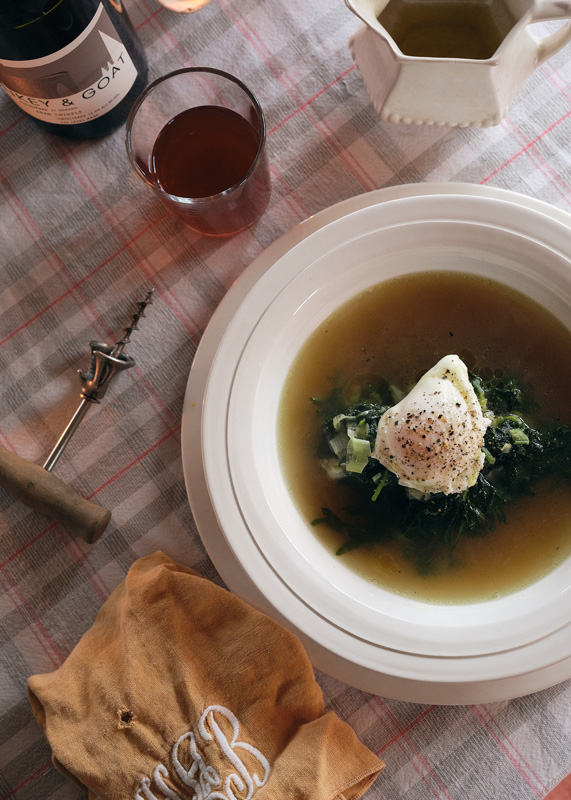
4 cups bone broth (chicken, beef, or pork) or rich vegetable stock 2 Tbsp. avocado oil 1 large bunch swiss chard, stems included, washed and roughly chopped 1.5 oz shiitake mushrooms, cleaned, trimmed, and thinly sliced Sea salt to taste Pinch red chile flakes 1-2 garlic cloves, peeled and sliced 2 medium leeks, cleaned, trimmed and thinly sliced, white and pale green parts only 2 local organic pastured eggs Good olive oil, for finishing Pink sea salt, for finishing Finely grated pecorino romano for finishing, optional
Heat a large saute pan over high heat. Add the avocado oil, reduce the heat to medium, and add the greens and shiitakes, stirring to coat in the oil.
Season lightly with sea salt and add the chile flakes and sliced garlic.
When the greens are wilted but still al dente add the sliced leeks, stirring to combine.
Continue cooking the greens and leeks until tender, but the leeks are still holding their shape. Season to taste, remove from heat and set aside.
Warm the broth in a medium saucepan to simmering and skim any impurities that rise to the surface with a fine mesh strainer. Season lightly to taste, if needed.
Swirl the broth with a spoon and poach the eggs one at a time, swirling each time, just until the whites are opaque but the yolks are still runny. Remove each egg to a shallow bowl.
Mound half the warm greens in each of two wide shallow soup bowls, placing a poached egg on top. Pour piping hot broth into each bowl, surrounding and covering the greens.
Finish with a pinch of pink salt, freshly ground pepper, a drizzle of good olive oil, and a shower of grated pecorino, if using.
Brown Butter-Roasted Apples with Bourbon and Cream
Serves 2-4. Like apple pie with an “edge” instead of a crust. We’re so lucky that local and regional apples are available all year long here, thanks to their ability to store way beyond harvest, and of course it’s always a bonus to have friends with apple trees!
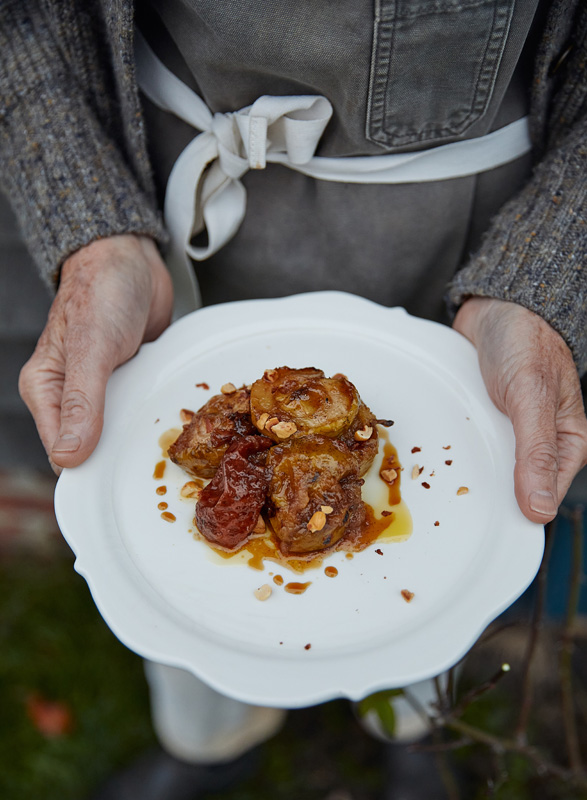
4 medium cooking apples, such as Braeburn, Mutsu, or Pink Lady 6 Tbsp. unsalted butter 1 vanilla bean, sliced lengthwise, seeds scraped, pod reserved 3 Tbsp. pure cane sugar 1/4 tsp. nutmeg, freshly grated 1/4 tsp. sea salt 2 Tbsp. pure maple syrup 2 Tbsp. bourbon 1 cup heavy whipping cream
Preheat the oven to 425° F
Heat a large sauté pan over medium heat. Add the butter, vanilla seeds and vanilla pod and continue cooking, shaking the pan periodically, until butter smells nutty and turns brown, about 7 minutes.
Turn off the heat, removing and discarding the vanilla bean pod.
Cut the apples in half from stem to root (coring if desired), then toss with the rest of the ingredients in a mixing bowl.
Place the apples cut side up in a baking dish, scraping the butter-sugar mixture on top.
Bake the apples in the oven, basting frequently, until deeply caramelized and tender, about 35 minutes.
Serve warm with unsweetened softly whipped cream or creme fraiche.
Kitchen wish list
I am incredibly lucky to be dreaming about a brand-new kitchen that will have materialized sometime (well, because we have an awesome crew!) in the not-too-distant future when our new house is completed.
Here are some of the kitchen items on my still-being-considered “wish list”:
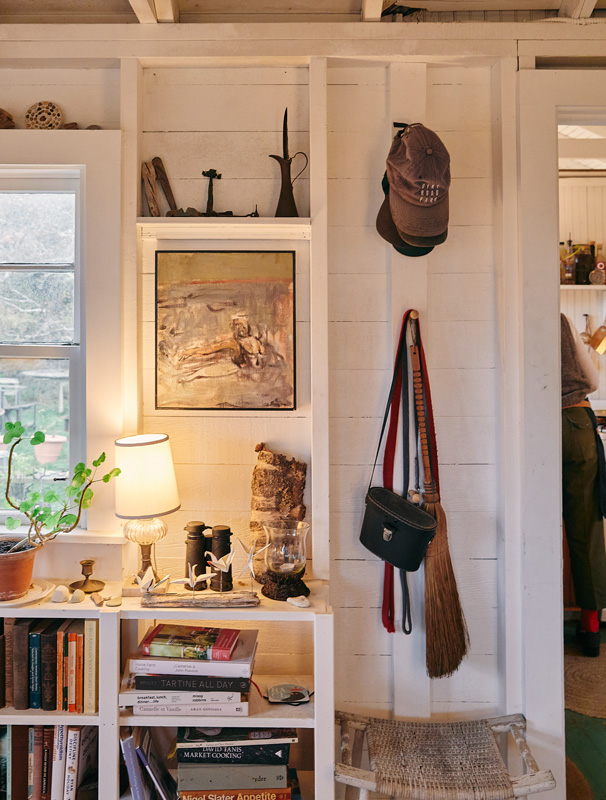
1. With a newly constructed wood-burning cooking hearth in my kitchen (my greatest wish and I got it!), I am researching Tuscan and/or Argentine grills to use in it — possibly with an additional accessory for cooking a la plancha.
2. I would like to upgrade my current large compost bucket to an XL one. Even though it will take up more counter space, I won’t have to empty it as frequently — because while I try to use every bit of a vegetable (nose to tail) the scraps still add up quickly!
3. If I can have a longer-than-usual magnetic knife strip, I will be really happy. Obviously, anything made of metal can attach to it — so I would love to take advantage of that and have fewer things jumbled in a drawer. Plus, one cannot have too many knives.
4. Speaking of knives, I usually sharpen mine on a stone, which is to say I do not sharpen them frequently enough. I was so impressed with how sharp my kids’ knives were when I visited them recently in LA — turns out they had just invested in a brand-new excellent knife sharpener. So I want one of those!
5. With all the canning and preserving I do, I need to replace my favorite kitchen scale (it lost a bolt or something), the old-school analog upright kind with a stainless steel bowl that holds a hefty pile of quinces or cucumbers.

